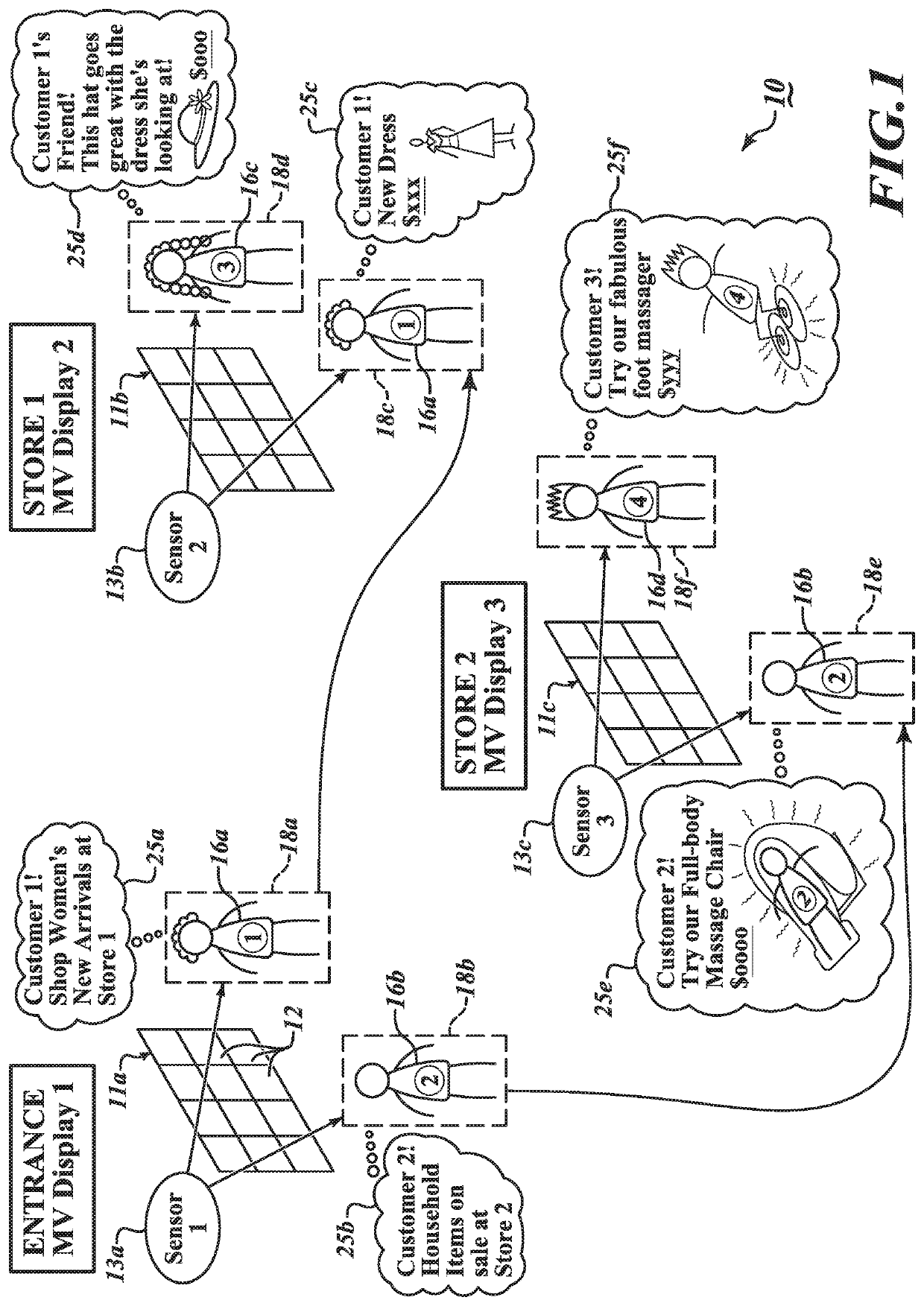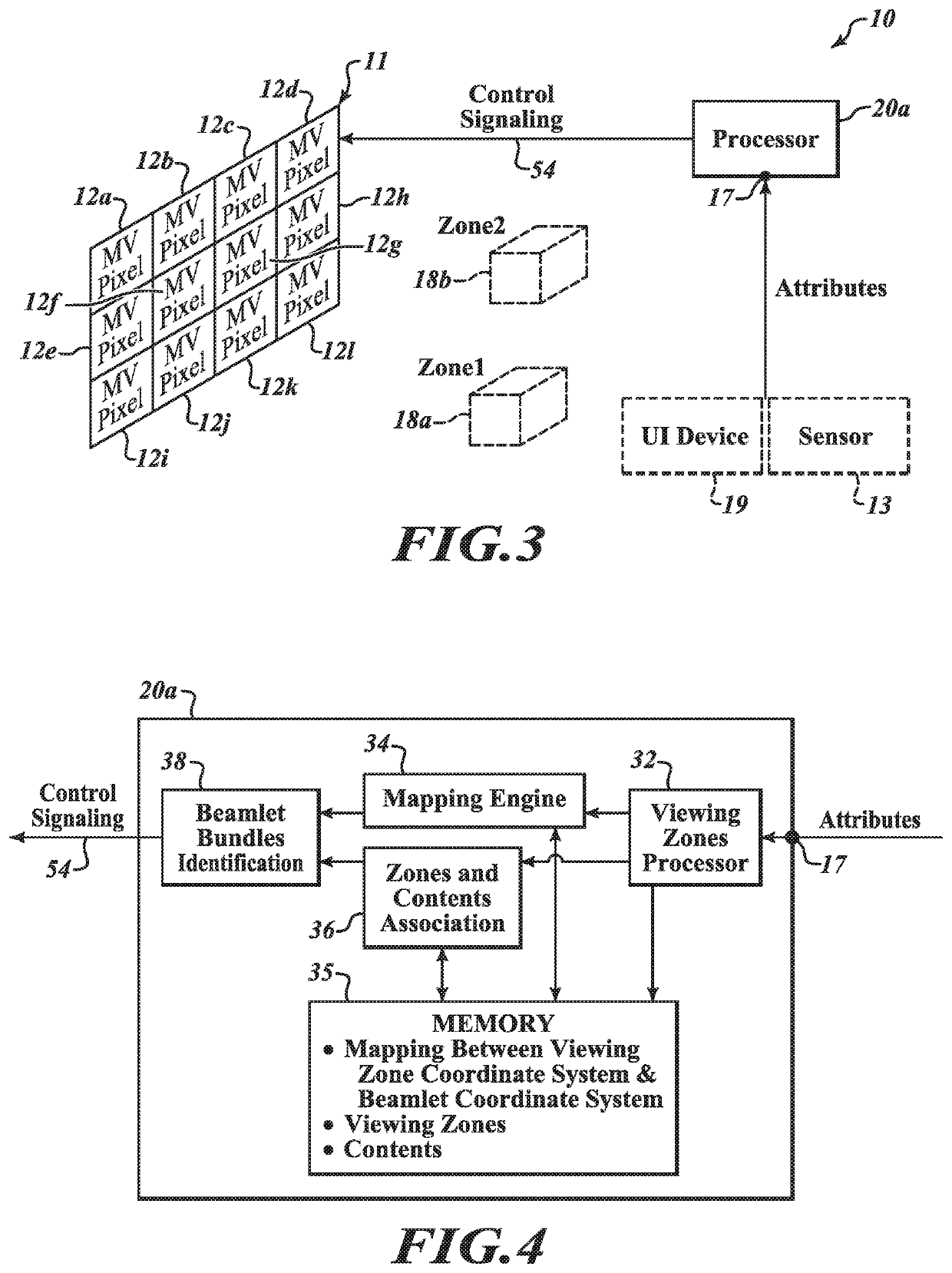[0012]For each of first and second images generated from the first and second targeted advertising contents, the system controller, using the mapping between the viewing zone coordinate system and the beamlet coordinate system, identifies a bundle of beamlets from the MV pixels of the MV display directed to the first or second viewing zone to form the first or second image. The bundle of beamlets directed to the first viewing zone to form the first image visible to the first viewer is different from the bundle of beamlets directed to the second viewing zone to form the second image visible to the second viewer. Thus, the MV advertising system and method according to various embodiments are capable of presenting targeted advertisements to multiple viewers / shoppers within view of a single MV display independently of each other, simultaneously, to make targeted advertising possible in a physical store setting.
[0015]In other embodiments, the MV advertising system includes a sensing system that provides real-time information on, for example, the location of viewers as they move around and hence the location of viewing zones in association with the location of viewers. The sensing system may additionally provide information regarding the viewers' identity, behavior, observable demographics, or other characteristics, which may be used by the system controller as the first and second attributes to select the right targeted advertising content. The system controller may also draw on data (the first and second attributes) that is available from other sources, including preference information for the particular customer, prior purchase history, or any other relevant data, retrievable from storage devices, from networks, etc. In this way, the system controller may determine and provide the targeted advertising content that is tailored or customized for each of multiple viewers within range of the MV display.
[0016]In further embodiments, the MV advertising system selects the targeted advertising content for each viewer based not only on the single viewer and his or her characteristics, but also on other viewers and their characteristics within range of the MV display. For example, the sensing system may provide the identities of viewers within range, and using other data, recognize relationships such as a husband and a wife shopping together. In a group shopping situation, purchase decisions are often arrived at collectively, and the advertising may be adjusted to optimize for this situation. A husband and wife might be shown different information to help them make a collective decision to purchase the product. In a further example, a store may have a series of products on display, and there may be a case that one particular product would be best advertised to each individual of the group. However, there may be constraints, such as lack of display space, for all current customers to examine the product simultaneously. In this case, it may be preferred to direct some customers to less optimal products rather than losing the sale altogether, so as to create the highest value for the group overall. Various embodiments of the MV advertising system and method allow for this sort of group optimization.
[0017]In some embodiments, the targeted advertising contents to be directed at multiple viewers are determined through a market process. For example, the market process may consist of an auction, in which prospective advertisers may bid on the right to display their chosen advertisement to a viewer with certain attributes. For example, a prospective advertiser may place a bid to show an ad for their gluten-free product to a customer, who is known or otherwise determined to prefer gluten-free products and is within range of the MV display. Similarly, a different prospective advertiser may choose to place a bid to show an ad to a customer who prefers all natural products. These bids are entered via a marketplace. The marketplace may present possible advertising scenarios (e.g., as a combination of attributes) to potential ad buyers, and allow them to bid for or otherwise purchase or obtain those advertising scenarios. For example, instead of an auction, various combinations of attributes may be put on a market in the form of a pricing menu published to prospective advertisers. The marketplace may operate in a pre-ordered fashion, for example, where bids are placed in anticipation of a particular scenario as exemplified above (e.g., the presence of a customer known to prefer gluten-free products or natural products). Alternatively, the marketplace may operate in real-time—presenting a current advertising opportunity with particular attributes to solicit immediate bids or offers of purchase, which are quickly evaluated to determine the advertising content which is shown moments later. The real-time option allows potential advertisers to incorporate sophisticated decision making that constantly changes their advertising strategies. Further alternatively, the marketplace may allow both real-time bidding as well as pre-arranged bids.
[0018]Use of the MV display allows the MV advertising system to display different advertising to different viewers simultaneously from the same MV display. In various embodiments, the MV advertising system relies on an ability to precisely target individual viewers to direct information in numerous directions, in 2D or 3D, with high angular resolution to differentiate among multiple customers in a typical shopping situation. MV advertising systems according to various embodiments are capable of high angular resolution and can precisely target content or media deliveries to individuals in a crowd.
[0019]The ability to show content differentiated to each individual, or differentiated to precisely defined zones, is highly valuable in venues shared by many people—such as retail, dining, and entertainment areas. It allows the personalization of messaging that people have come to expect from online / on-phone retail experiences. It incorporates this messaging into the environment rather than on a little screen. It gives the retailer or venue-designer control of how the messaging is incorporated into the overall experience. It leverages real-time observation of the environment and the shopper to create targeted messaging. It further allows messaging in public spaces to be charged / marketed to advertisers by specific criteria, similar to online advertising, while increasing the number of advertisers who can share an MV display. These advantages are not available through other advertising or messaging techniques or technologies, and are made possible by use of the multi-view (MV) display systems.
 Login to View More
Login to View More  Login to View More
Login to View More 


